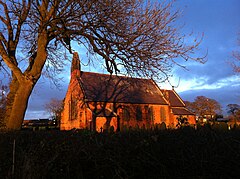Shevington
| Shevington | |
|---|---|
 St Anne's Church in Shevington |
|
| Shevington shown within Greater Manchester | |
| Population | 10,000 |
| OS grid reference | SD542086 |
| Metropolitan borough | |
| Metropolitan county | |
| Region | |
| Country | England |
| Sovereign state | United Kingdom |
| Post town | WIGAN |
| Postcode district | WN6 |
| Dialling code | 01257 |
| Police | Greater Manchester |
| Fire | Greater Manchester |
| Ambulance | North West |
| EU Parliament | North West England |
| UK Parliament | |
Shevington is a village and civil parish within the Metropolitan Borough of Wigan, England. The population of the Wigan ward called Shevington and Lower Ground had increaded to 11,482 at the 2011 Census.
Lying within the historic county boundaries of Lancashire, Shevington lies approximately 3 miles (4.8 km) from Wigan town centre, 3.5 miles (5.6 km) from Skelmersdale and at the 2001 census had a population of 9,786.
Shevington, a farmstead near a hill called shevin, derives from the Celtic cevn meaning a ridge and the Old English tun, a farmstead. It is a hill slope settlement in the Douglas Valley recorded in documents in 1225 as Shefington. Other recorded spellings include Scheuynton in 1253, Sheuington in 1277, Sewinton 1288 and Sheuynton in 1292.
Shevington became a manor, an estate system of local government held of the king by a Lord of the Manor from the 12th to the 18th centuries. The area was included within the ecclesiastical parish of Standish until 1887 when it was granted separate status with the consecration of St Anne's Church.
From earliest times the area had a sparse and scattered population eking out a living from the common and wood and farmlands owned by the church including Burscough Priory, Cockersand Abbey and the Knights Hospitallers until the Dissolution of the Monasteries from 1536 and that of the local gentry included Sir Adam Banastre, Lord of the Manor in 1288 and the Standish, Catterall, Stanley, Rigby, Hulton, Dicconson and Hesketh families – the last being the last Lord of the Manor in 1798.
...
Wikipedia

